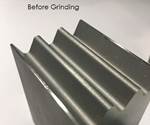Smoothing the Way for Production 3D Printing
In additive manufacturing of end-use parts, attention turns to the secondary steps.
RedEye is a Minnesota contract manufacturer making functional parts through 3D printing. Specifically, the company makes these parts for customers through fused deposition modeling (FDM), the 3D printing process from Stratasys that builds fully functional parts from engineered plastics. RedEye’s headquarters facility has 89 FDM machines—enough to accommodate large-quantity production. Even so, the company’s workload has tended to skew toward prototypes, though that may now be starting to change.
RedEye project engineering manager Bill Camuel says the company is seeing more interest from customers in 3D printing for final production. No change in the FDM machines accounts for this. Instead, the relevant change relates to what now comes after FDM. Recently, RedEye completed beta testing of various finishing methods for FDM parts, and has officially introduced these finishing methods as part of its range of services.
Appearances matter, Mr. Camuel says. For a component that the consumer or end user will see, appearances matter a great deal.
“People associate FDM with layer lines,” he says. The parallel lines marking each distinct layer of the 3D printed component are visible in the part’s surface. One way to remove these lines is through hand sanding. However, hand sanding is at best a second choice for production parts. Options involving less manual effort are quicker and more cost-effective.
Tumbling, for example, is now an option the company routinely applies. Experimentation with this finishing method involved finding the right tumbling media and duration for various plastics employed in FDM. It also involved observing various parts to learn which features are too delicate for tumbling, and therefore require a manual process after all. Yet another aim was to learn just how far tumbling can go to improve the look of the part, and what level of aesthetic quality it can achieve.
In the case of parts with demanding appearance requirements, Mr. Camuel says the company might tumble the part to remove the layer lines, followed by vapor smoothing to bring out the surface luster. RedEye engineers now have various finishing options to choose from in search of the appearances customers are seeking. Along with tumbling, vapor smoothing and sanding, other options include bead blasting, buffing and plating. Plus, the very way that the part is oriented during the process of building it in layers is often another important factor affecting the appearance of a 3D printed part.
The value of these aesthetic considerations illustrates how near 3D printing is to being accepted as a commonplace production process, Mr. Camuel says. Customers are ready to use parts manufactured through 3D printing, if only the supplier can carry the parts through to completion. In addition to finishing, he says, that completion also often entails adding features that FDM cannot produce effectively, such as tapped holes. To that end, another secondary processing step that is growing in importance for RedEye is machining.
Related Content
-
DMG MORI: Build Plate “Pucks” Cut Postprocessing Time by 80%
For spinal implants and other small 3D printed parts made through laser powder bed fusion, separate clampable units resting within the build plate provide for easy transfer to a CNC lathe.
-
Casting With Complexity: How Casting Plus 3D Printing Combine the Strengths of Both
Aristo Cast is advancing a mode of part production in which casting makes the part, but 3D printing enables the geometry.
-
Large-Format “Cold” 3D Printing With Polypropylene and Polyethylene
Israeli startup Largix has developed a production solution that can 3D print PP and PE without melting them. Its first test? Custom tanks for chemical storage.

.jpg;width=70;height=70;mode=crop)








.png;maxWidth=300;quality=90)





